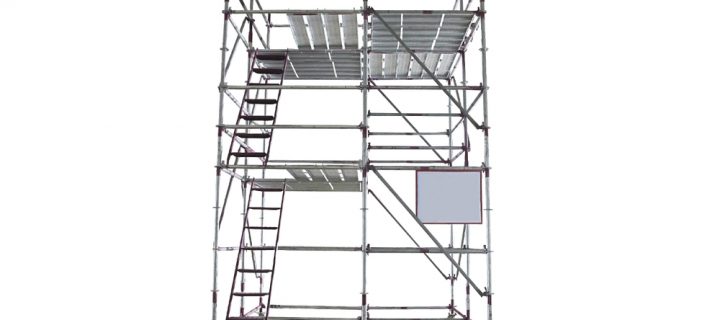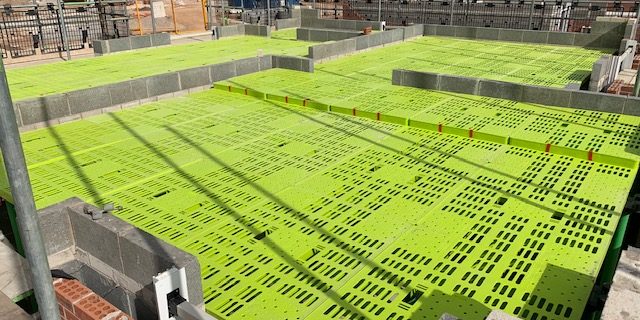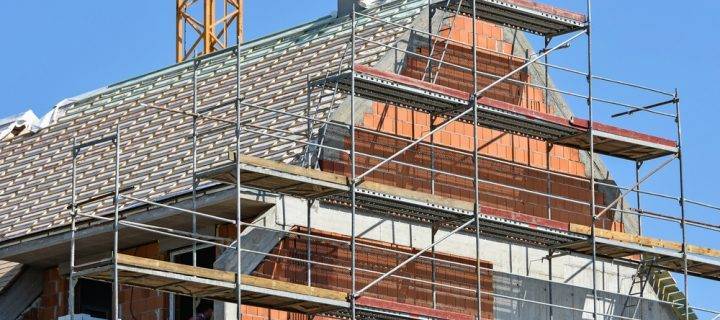Mobile alloy towers from Network Scaffold combine the best features of several other pieces of equipment that are designed for working at height. Mobile scaffold towers provide a minimal amount of added height and add stability that a conventional extension ladder does not. Also, stepladders can provide a stable platform to work on but lack the significant height that mobile towers provide. If you have never used a mobile access tower before, we have put together five reasons to make the change from conventional height access equipment in this blog. 5 Reasons to Choose Our Mobile Alloy Towers 1. Stability – One of the main reasons to consider a mobile scaffold tower is the stability they provide. Unlike two-legged ladders, mobile towers support themselves standing alone and do not need to be positioned against another structure to remain upright. A mobile tower can maintain stability even when a worker climbs up the access ladder or is working with tools on the working platform. Many mobile towers have additional support legs which can be fitted around the base to increase stability. The support legs act in the same way as extendable legs that are found on mobile cranes or cherry picker vans. Increasing the area of the mobile access tower’s base means the structure is less likely to become unbalanced or tip over when being used. 2. Adaptability – While mobile towers could look ungainly at first glance they are highly adaptable. Providing a safe platform for working at height, they can also be used in jobs both indoors and out. The working platform is surrounded by support bars on each side, allowing workers to carry out tasks on surfaces in front of them plus directly above them. Some mobile scaffold towers also fit together with a modular design, meaning extra height can be added if required. 3. Mobility – Mobility is one of the main reasons our clients choose mobile scaffold towers. Instead of assembling and disassembling a scaffold tower, mobile towers have wheels attached to each of their legs that make them more convenient for different scenarios. The wheels at the base of each leg can be locked and unlocked which allows workers to wheel the tower around...
Read Moreabout Why Should I Use a Mobile Alloy Tower?Alloy towers are one of the most important parts of our scaffolding services, but do you know how to erect them? For this blog, Network Scaffold will share our 12 step guide to erecting stairwell alloy towers. 12 Steps to Using Stairwell Alloy Towers Have two people available to erect all towers for safety reasons. Before the tower is erected you will need to ensure site conditions are safe. Operatives need to be competent and familiarise themselves with the manual for assembly. Sufficient equipment also needs to be available to erect the tower at the height required whilst checking components are not damaged or incompatible plus checking the tower breakdown. Insert the adjustable legs and baseplates into the opening base ladder frames. Place the two ladder frames on the staircase in the position required, roughly 1.5 metres apart with the baseplates fully located on the steps of the staircase with the offset plate facing inwards towards the centre of the frame. Connect the two bottom rungs of the frames using a diagonal brace. The brace hooks should be located at the centre of the bottom rungs of the ladder frames which prevents clashing using an erection platform. Level the frames by turning the adjustable leg nuts so that the bottom rung of the frame on the upper step is at the same level as the top rung of the frame on the lower steps with the adjustable legs extended if necessary to achieve this. Fit a trapdoor platform with the trapdoor end located at the lower part of the stairs, to the bottom rung of the frame on the upper step and to the top rung of the ladder frame on the lower step. Make sure the platform is level. There is a small bubble level on the underside of all stair deck alloy towers to ease levelling. This platform will be used for the temporarily safe erection of the tower and will be removed later when being used further up the tower. From the bottom of the staircase, fit a six rung upper frame to the top of the ladder frame on the lower step. Lock the frames together with the interlock clips. Climb into the middle of...
Read Moreabout How to Erect Stairwell Alloy TowersConstruction hoarding is defined as a fence or barrier between a construction site and the public; with the purpose to simply keep workers safe. Construction sites that are based along pedestrian walkways need plastic hoarding to ensure that there is no interference on-site from the general public. Although additional labour is required, this is definitely a necessary hassle to help keep your site safe. For this blog, Network Scaffold Services will share some of the benefits of hoarding plus some intriguing insights. The Advantages of Construction Hoarding Here are the three main benefits of construction hoarding – Public Safety – As previously mentioned public safety is one of the most benefits of using our construction hoarding. This is the reason a lot of construction sites that are near to public access areas use our products. Hoarding also shows people they cannot enter the area plus you can further enforce the message with signage on your hoarding. To make sure the hoarding is reliable, we would recommend using a system that is wind resistant and safely secured into a base or the ground to prevent tipping. Site Security – One of the best things about using site hoarding is that it keeps your project away from prying eyes. If you are looking to keep your project under wraps, hoarding acts as a visible barrier between your site and the public. The public will also not be able to see your materials and tools being stored on-site, protecting them from potential theft. Branding Your Site – From a marketing perspective, construction hoarding is one of the simplest branding opportunities you can have. Your investment in keeping the public safe can also double as a way to advertise your upcoming project. Branding your site will add brand recognition plus could potentially increase interest and sales once the site opens. Get in Touch for More Information If you have any questions about plastic hoarding available from Network Scaffold Services, please do not hesitate to contact us today. We are also the leading provider of scaffolding and safety decking for clients across...
Read Moreabout What is Construction Hoarding?Safety decking from Network Scaffold Services offers a safe loading solution for a wide variety of construction projects. We have recently started offering safety decks plus plastic hoarding to help give our clients the complete selection of scaffold systems. Network Scaffold are renowned for top quality safety procedures, so investing in durable, multifaceted safety decks was a valuable venture to create the most efficient working environments on construction sites across Derby and the surrounding areas. Safety decks are a fall prevention work platform that protects site workers from any falls from height; which is the number one risk for scaffolders. They also provide a loading workable platform that is often necessary to complete a construction project. 5 Reasons to Choose Our Safety Decking 1. Reduce Installation and Dismantle Times – Traditional scaffolding tubular birdcages are more difficult to put up and take back down. Using safety decks can cut your installation and dismantling times by 70% (according to industry statistics) plus reduce the labour for staff and get the job done much quicker. 2. Ease Pressure on Building Areas – Decking solutions are extremely lightweight with any pressure they add to a build being minimal. You will also limit the weight on the level itself as it lowers the amount of loading required as this will be on deck instead. 3. Self-Contained – Safety decks are an entirely standalone piece of equipment and are completely self-supporting which ensures there is little disruption to your project when it is brought in and taken back out. 4. Installation Doesn’t Require Any Work at Height – One of the main reasons safety decks are used is to maximise safety on sites. Throughout both the installation and dismantle your workers won’t need to worry about working at height. 5. Increased Load Capacity – Internal decking increases your loading capacity meaning your workers can get on with their job with less risk attached to getting on and off the scaffold. Get in Touch With Any Questions If you have any questions about safety decking from Network Scaffold Services, please do not hesitate to contact us...
Read Moreabout Why Should I Use Safety Decking?A new mixed-use development has been announced for the edge of Nottingham, which will create 3000 homes with plenty of scaffolding needed. The £83m packages of Government funding will support the delivery of the infrastructure at Fairham and create new homes and jobs in the area. This project will also deliver a new school, community centre, health centre, sports pitches, community parks plus woodland. Robert Hepwood, Land and Planning Director at Clowes Developments, said: “This funding package from the Government really helps us to make progress on-site across Fairham and start to realise our vision of a green and distinctive new district for Nottingham. “By working in partnership with public bodies we can now accelerate the delivery of new jobs and new homes for Nottinghamshire. We’re sure that people will begin to see further progress on-site throughout this year with our first new homes due to start construction in the autumn.” Next, we will discuss why scaffolding will be crucial to help the project be completed in the quickest time. Knowing When You Need Scaffolding Scaffolding from Network Scaffold Services is required once a thorough risk assessment has concluded it is needed. A risk assessment must by law be carried out on any job where any employees are working at height. It is not a legal requirement when an individual is completing the work privately, but it is common sense to take your safety seriously. Employees that are working at height must by law be safeguarded. Although low-risk jobs such as minor roof repairs to domestic properties could use a ladder, we would always recommend utilising scaffolding or a working platform for Health and Safety reasons as they increase stability and reduce the risk of accidents happening. If you are planning to be working at heigh for long periods of time or moving about at height, then it is important to have a safe working platform such as an appropriately designed scaffolding system. Talk to the Experts If you have a domestic or commercial project in the planning stages, don’t forget to enquire about scaffolding from Network Scaffold. For more information please contact us...
Read Moreabout New Homes in Nottingham Will Need Scaffolding




